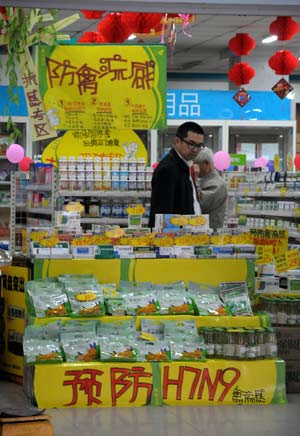
Banlangen has become a hot commodity in pharmacies across the country. HUANG HE / FOR CHINA DAILY
The avian flu outbreak has caused consternation and while some believe the TCM herb banlangen can prevent and treat the disease, experts are counseling a more cautious approach. Wang Hongyi in Shanghai and Liu Zhihua in Beijing report.
The traditional Chinese medicine banlangen has once again come under the spotlight because of an outbreak of the H7N9 strain of avian flu that has infected 28 people and left eight of them dead, according to the country's health authorities.
Banlangen, also known as Isatis root, from the biennial plant Isatis indigotica Fortunehas, has been used medicinally for about two millennia to reduce fevers and combat viruses. Banlangen was used in the fight against severe acute respiratory syndrome, or SARS, in 2003, when Zhong Nanshan, director of the Guangzhou Institute of Respiratory Diseases, recommended the herb as an antivirus medicine.
Since then, banlangen has been widely used and is said to have played an important role in preventing H5N1 avian flu and H1N1 flu over the past decade.
From a TCM viewpoint, banlangen is a cold compound that can dissipate heat, cool the blood and provide relief for sore throats and upper respiratory infections.
Pharmacological studies show banlangen has antibacterial and antiviral properties, is effective against Leptospira spirochaete bacteria, detoxifies, boosts the immune system, and kills off leukemia cells.
As production technology of the herb has progressed, it can be produced in more varied forms for consumption, such as granules and tonic drinks.
When H7N9 bird flu was first reported in early April, some health experts recommended banlangen to prevent further infections and the herb quickly sold out in pharmacies across the country.
Even so, there are doubts about the efficacy of the herb in combating H7N9 bird flu, and many experts are recommending that consumers do not take large doses over a long period of time, especially the elderly, pregnant women and children.

Copyright ©1999-2011 Chinanews.com. All rights reserved.
Reproduction in whole or in part without permission is prohibited.